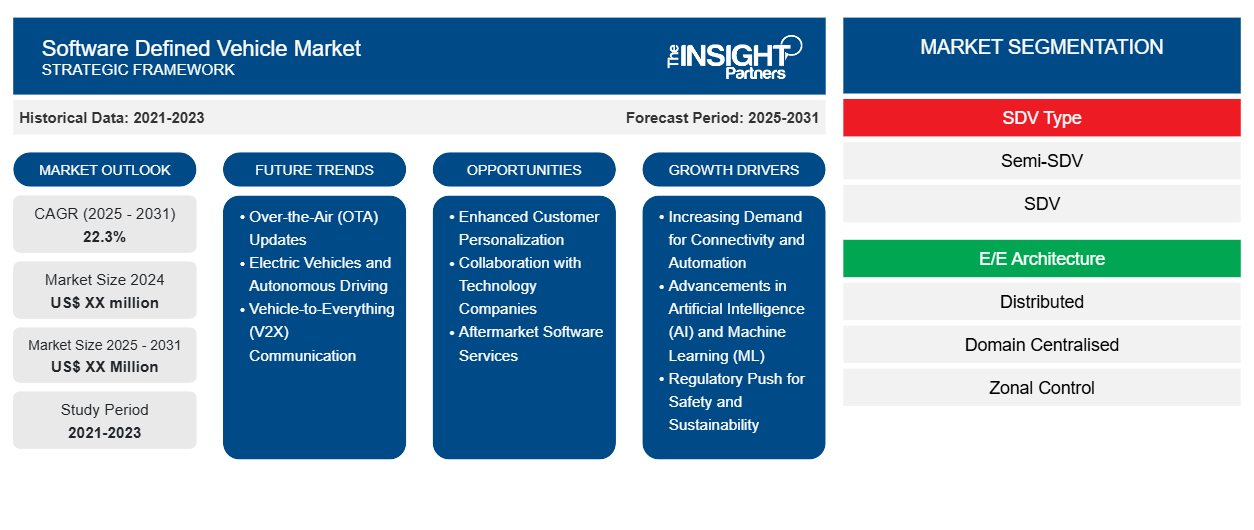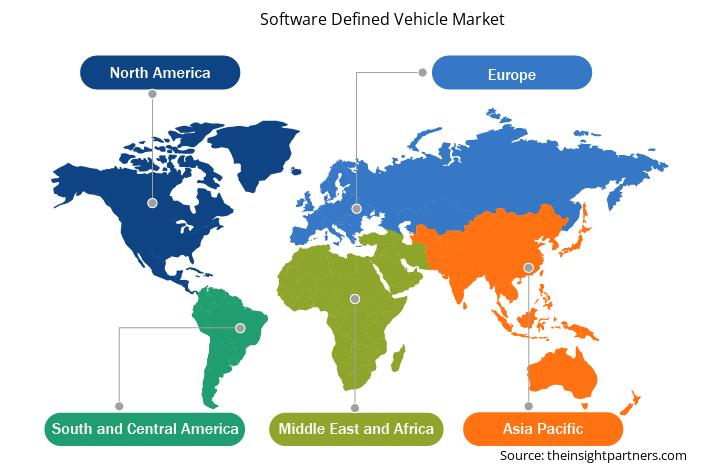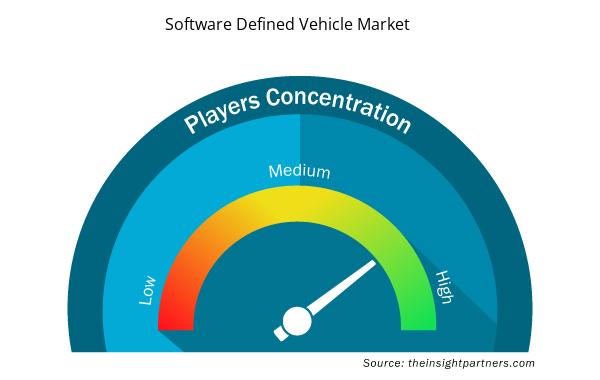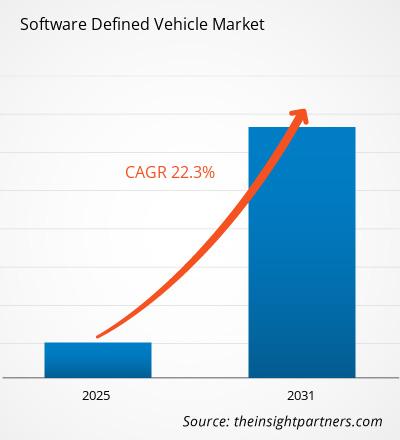ソフトウェア定義車両市場は、2025年から2031年にかけて22.3%のCAGRを記録し、市場規模は2024年のXX百万米ドルから2031年にはXX百万米ドルに拡大すると予想されています。
本レポートは、SDVタイプ(セミSDV、SDV)、E/Eアーキテクチャ(分散型、ドメイン集中型、ゾーン制御型)、車両タイプ(乗用車および小型商用車)別にセグメント化されています。グローバル分析は、地域レベルおよび主要国別にさらに細分化されています。本レポートでは、上記の分析およびセグメントの米ドル建て価値を提供しています。
報告書の目的
The Insight Partnersによるレポート「ソフトウェア定義車両市場」は、現状と将来の成長、主要な推進要因、課題、そして機会を解説することを目的としています。これにより、以下のような様々なビジネスステークホルダーに洞察を提供します。
- テクノロジープロバイダー/メーカー: 進化する市場の動向を理解し、潜在的な成長機会を把握することで、情報に基づいた戦略的意思決定を行うことができます。
- 投資家: 市場の成長率、市場の財務予測、バリュー チェーン全体に存在する機会に関する包括的な傾向分析を実施します。
- 規制機関: 市場の濫用を最小限に抑え、投資家の信用と信頼を維持し、市場の健全性と安定性を維持することを目的として、市場における政策と警察活動を規制します。
ソフトウェア定義車両市場のセグメンテーション
SDVタイプ
- セミSDV
- SDV
E/Eアーキテクチャ
- 分散型
- ドメイン集中化
- ゾーンコントロール
車両タイプ
- 乗用車および小型商用車
地理
- 北米
- ヨーロッパ
- アジア太平洋
- 中東およびアフリカ
- 南米と中央アメリカ
要件に合わせてレポートをカスタマイズ
このレポートの一部、国レベルの分析、Excelデータパックなど、あらゆるレポートを無料でカスタマイズできます。また、スタートアップや大学向けのお得なオファーや割引もご利用いただけます。
ソフトウェア定義車両市場:戦略的洞察

- このレポートの主要な市場動向を入手してください。この無料サンプルには、市場動向から見積もりや予測に至るまでのデータ分析が含まれます。
ソフトウェア定義車両市場の成長要因
- コネクティビティと自動化への需要の高まり:消費者がコネクティビティの向上や自動運転などの高度な機能を求めるにつれ、SDV(Software-Defined Vehicle:ソフトウェア統合車両)は不可欠な存在になりつつあります。ソフトウェア統合により、車両と他のデバイス、ネットワーク、クラウドプラットフォーム間のシームレスな通信が可能になります。リアルタイムデータ転送は、OTA(Over-The-Air)アップデート、先進運転支援システム(ADAS)、インフォテインメントシステムなど、運転体験を向上させる様々な機能をサポートします。
- 人工知能(AI)と機械学習(ML)の進歩:SDVにAIとMLアルゴリズムを適用することで、運転者の行動、道路状況、交通パターンを学習できるようになり、安全性、予知保全、パフォーマンスの最適化が向上します。これらの技術が進化するにつれて、SDVはよりインテリジェントになり、より優れた意思決定能力とユーザーエクスペリエンスを提供します。
- 安全性と持続可能性に向けた規制の推進:世界中の政府は、車両の安全基準と環境の持続可能性を重視しています。SDVは、衝突回避、緊急ブレーキ、車線維持支援といった高度な安全機能を統合できるため、メーカーはこれらの規制要件を満たすことができます。さらに、SDVはバッテリー管理とエネルギー効率を最適化できるため、電気自動車(EV)やグリーンテクノロジーへの移行はソフトウェア統合の恩恵を受けます。
ソフトウェア定義車両市場の将来動向
- 無線(OTA)アップデート:最も有望なトレンドの一つは、OTAソフトウェアアップデートの利用増加です。これにより、メーカーは車両の機能と性能をリモートで向上させることができます。このトレンドは、ディーラーに出向くことなく新機能や改善点を提供することでユーザーエクスペリエンスを向上させるだけでなく、メーカーがバグや脆弱性をより迅速に修正し、車両のセキュリティと信頼性を向上させることにもつながります。
- 電気自動車と自動運転:SDV(標準車両)は、電気自動車と自動運転車の発展において極めて重要な役割を果たすと期待されています。これらの車両に搭載されるソフトウェアは、バッテリー効率、エネルギー消費、そして自動運転システムの管理を担います。特に排出ガス規制の厳格化に伴いEVの需要が高まるにつれ、SDVはこれらの新しい車両アーキテクチャを性能、航続距離、そして安全性の観点から最適化する上で重要な役割を果たすでしょう。
- V2X(Vehicle-to-Everything)通信:SDV(車両間通信)への移行は、車両同士や周囲のインフラと通信するV2X技術の導入を加速させます。この通信により、安全性の向上(衝突回避など)、交通の流れの円滑化、そして交通ネットワークの効率化が実現します。V2Xは、車両とスマートシティの連携を強化し、SDVの機能をさらに強化します。
ソフトウェア定義車両市場の機会
- 強化された顧客パーソナライゼーション:ソフトウェア統合により、SDVは個人の好み、運転習慣、さらには環境条件に基づいて、高度にパーソナライズされた体験を提供できます。例えば、ドライバーのプロフィールや気分に基づいて、シートの位置、空調、エンターテイメントの好みなどの設定を調整します。こうしたパーソナライズされた体験は、顧客ロイヤルティの向上につながり、競争の激しい市場において自動車メーカーの差別化につながります。
- テクノロジー企業との連携:自動車メーカーは、テクノロジー企業、ソフトウェア開発者、クラウドサービスプロバイダーと提携する大きなチャンスを持っています。これらの連携は、高度なインフォテインメント、AIを活用した機能、強化されたセキュリティプロトコルなど、より高度な車両機能の開発につながる可能性があります。さらに、テクノロジー企業との提携はイノベーションを加速させ、新機能の市場投入までの時間を短縮することにもつながります。
- アフターマーケット・ソフトウェア・サービス:SDV(小型車)のソフトウェアがますます高度化するにつれ、アフターマーケット・サービス業界のビジネスチャンスは拡大しています。メーカーは購入後も追加のソフトウェアパッケージ、アップデート、または機能強化を提供できるため、オーナーは車両を継続的に改良・カスタマイズすることができます。これは、自動車メーカーとサービスプロバイダーの両方にとって新たな収益源となる可能性があります。
ソフトウェア定義車両市場の地域別分析
Insight Partnersのアナリストは、予測期間を通じてソフトウェア定義車両市場に影響を与える地域的なトレンドと要因を詳細に解説しています。このセクションでは、北米、ヨーロッパ、アジア太平洋、中東・アフリカ、中南米におけるソフトウェア定義車両市場のセグメントと地域についても解説します。

- ソフトウェア定義車両市場の地域別データを入手
ソフトウェア定義車両市場レポートの範囲
| レポート属性 | 詳細 |
|---|---|
| 2024年の市場規模 | XX百万米ドル |
| 2031年までの市場規模 | XX百万米ドル |
| 世界のCAGR(2025年~2031年) | 22.3% |
| 履歴データ | 2021-2023 |
| 予測期間 | 2025~2031年 |
| 対象セグメント | SDVタイプ別
|
| 対象地域と国 | 北米
|
| 市場リーダーと主要企業の概要 |
|
ソフトウェア定義車両市場のプレーヤー密度:ビジネスダイナミクスへの影響を理解する
ソフトウェア定義車両市場は、消費者の嗜好の変化、技術の進歩、製品メリットへの認知度の高まりといった要因によるエンドユーザー需要の高まりに牽引され、急速に成長しています。需要が高まるにつれ、企業は製品ラインナップの拡充、消費者ニーズへの対応のためのイノベーション、そして新たなトレンドの活用を進めており、これが市場の成長をさらに加速させています。
市場プレーヤー密度とは、特定の市場または業界内で事業を展開する企業または会社の分布を指します。これは、特定の市場空間における競合企業(市場プレーヤー)の数が、その市場規模または市場価値全体と比較してどれだけ多いかを示します。
ソフトウェア定義車両市場で事業を展開している主要企業は次のとおりです。
- アプティブ
- コンチネンタル
- フォード
- ゼネラルモーターズ
- マレリホールディングス
- メルセデス・ベンツ
免責事項:上記の企業は、特定の順序でランク付けされているわけではありません。

- ソフトウェア定義車両市場のトップキープレーヤーの概要を入手
主なセールスポイント
- 包括的なカバレッジ:レポートでは、ソフトウェア定義車両市場の製品、サービス、タイプ、エンドユーザーの分析を包括的にカバーし、全体的な展望を提供します。
- 専門家の分析:レポートは、業界の専門家とアナリストの深い理解に基づいて作成されています。
- 最新情報: このレポートは、最新の情報とデータの傾向を網羅しているため、ビジネスの関連性を保証します。
- カスタマイズ オプション: このレポートは、特定のクライアント要件に対応し、ビジネス戦略に適切に適合するようにカスタマイズできます。
したがって、ソフトウェア定義車両市場に関する調査レポートは、業界の状況と成長見通しを解明し、理解するための先導役となるでしょう。いくつかの妥当な懸念事項はあるものの、このレポートの全体的なメリットはデメリットを上回る傾向にあります。
- 過去2年間の分析、基準年、CAGRによる予測(7年間)
- PEST分析とSWOT分析
- 市場規模価値/数量 - 世界、地域、国
- 業界と競争環境
- Excel データセット



Report Coverage
Revenue forecast, Company Analysis, Industry landscape, Growth factors, and Trends

Segment Covered
This text is related
to segments covered.

Regional Scope
North America, Europe, Asia Pacific, Middle East & Africa, South & Central America

Country Scope
This text is related
to country scope.
よくある質問
Some of the customization options available based on the request are an additional 3–5 company profiles and country-specific analysis of 3–5 countries of your choice. Customizations are to be requested/discussed before making final order confirmation as our team would review the same and check the feasibility
The report can be delivered in PDF/PPT format; we can also share excel dataset based on the request
Electric Vehicles and Autonomous Driving is anticipated to play a significant role in the global software-defined vehicles market in the coming years
The major factors driving the software-defined vehicles market are:
1. Increasing Demand for Connectivity and Automation
2. Regulatory Push for Safety and Sustainability
The global software-defined vehicles market is expected to grow at a CAGR of 22.3% during the forecast period 2024 - 2031
Trends and growth analysis reports related to Technology, Media and Telecommunications : READ MORE..
The Insight Partners performs research in 4 major stages: Data Collection & Secondary Research, Primary Research, Data Analysis and Data Triangulation & Final Review.
- Data Collection and Secondary Research:
As a market research and consulting firm operating from a decade, we have published and advised several client across the globe. First step for any study will start with an assessment of currently available data and insights from existing reports. Further, historical and current market information is collected from Investor Presentations, Annual Reports, SEC Filings, etc., and other information related to company’s performance and market positioning are gathered from Paid Databases (Factiva, Hoovers, and Reuters) and various other publications available in public domain.
Several associations trade associates, technical forums, institutes, societies and organization are accessed to gain technical as well as market related insights through their publications such as research papers, blogs and press releases related to the studies are referred to get cues about the market. Further, white papers, journals, magazines, and other news articles published in last 3 years are scrutinized and analyzed to understand the current market trends.
- Primary Research:
The primarily interview analysis comprise of data obtained from industry participants interview and answers to survey questions gathered by in-house primary team.
For primary research, interviews are conducted with industry experts/CEOs/Marketing Managers/VPs/Subject Matter Experts from both demand and supply side to get a 360-degree view of the market. The primary team conducts several interviews based on the complexity of the markets to understand the various market trends and dynamics which makes research more credible and precise.
A typical research interview fulfils the following functions:
- Provides first-hand information on the market size, market trends, growth trends, competitive landscape, and outlook
- Validates and strengthens in-house secondary research findings
- Develops the analysis team’s expertise and market understanding
Primary research involves email interactions and telephone interviews for each market, category, segment, and sub-segment across geographies. The participants who typically take part in such a process include, but are not limited to:
- Industry participants: VPs, business development managers, market intelligence managers and national sales managers
- Outside experts: Valuation experts, research analysts and key opinion leaders specializing in the electronics and semiconductor industry.
Below is the breakup of our primary respondents by company, designation, and region:

Once we receive the confirmation from primary research sources or primary respondents, we finalize the base year market estimation and forecast the data as per the macroeconomic and microeconomic factors assessed during data collection.
- Data Analysis:
Once data is validated through both secondary as well as primary respondents, we finalize the market estimations by hypothesis formulation and factor analysis at regional and country level.
- Macro-Economic Factor Analysis:
We analyse macroeconomic indicators such the gross domestic product (GDP), increase in the demand for goods and services across industries, technological advancement, regional economic growth, governmental policies, the influence of COVID-19, PEST analysis, and other aspects. This analysis aids in setting benchmarks for various nations/regions and approximating market splits. Additionally, the general trend of the aforementioned components aid in determining the market's development possibilities.
- Country Level Data:
Various factors that are especially aligned to the country are taken into account to determine the market size for a certain area and country, including the presence of vendors, such as headquarters and offices, the country's GDP, demand patterns, and industry growth. To comprehend the market dynamics for the nation, a number of growth variables, inhibitors, application areas, and current market trends are researched. The aforementioned elements aid in determining the country's overall market's growth potential.
- Company Profile:
The “Table of Contents” is formulated by listing and analyzing more than 25 - 30 companies operating in the market ecosystem across geographies. However, we profile only 10 companies as a standard practice in our syndicate reports. These 10 companies comprise leading, emerging, and regional players. Nonetheless, our analysis is not restricted to the 10 listed companies, we also analyze other companies present in the market to develop a holistic view and understand the prevailing trends. The “Company Profiles” section in the report covers key facts, business description, products & services, financial information, SWOT analysis, and key developments. The financial information presented is extracted from the annual reports and official documents of the publicly listed companies. Upon collecting the information for the sections of respective companies, we verify them via various primary sources and then compile the data in respective company profiles. The company level information helps us in deriving the base number as well as in forecasting the market size.
- Developing Base Number:
Aggregation of sales statistics (2020-2022) and macro-economic factor, and other secondary and primary research insights are utilized to arrive at base number and related market shares for 2022. The data gaps are identified in this step and relevant market data is analyzed, collected from paid primary interviews or databases. On finalizing the base year market size, forecasts are developed on the basis of macro-economic, industry and market growth factors and company level analysis.
- Data Triangulation and Final Review:
The market findings and base year market size calculations are validated from supply as well as demand side. Demand side validations are based on macro-economic factor analysis and benchmarks for respective regions and countries. In case of supply side validations, revenues of major companies are estimated (in case not available) based on industry benchmark, approximate number of employees, product portfolio, and primary interviews revenues are gathered. Further revenue from target product/service segment is assessed to avoid overshooting of market statistics. In case of heavy deviations between supply and demand side values, all thes steps are repeated to achieve synchronization.
We follow an iterative model, wherein we share our research findings with Subject Matter Experts (SME’s) and Key Opinion Leaders (KOLs) until consensus view of the market is not formulated – this model negates any drastic deviation in the opinions of experts. Only validated and universally acceptable research findings are quoted in our reports.
We have important check points that we use to validate our research findings – which we call – data triangulation, where we validate the information, we generate from secondary sources with primary interviews and then we re-validate with our internal data bases and Subject matter experts. This comprehensive model enables us to deliver high quality, reliable data in shortest possible time.

 このレポートの無料サンプルを入手する
このレポートの無料サンプルを入手する